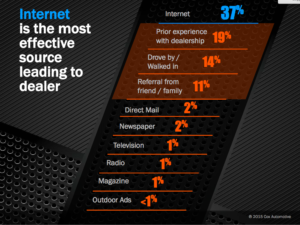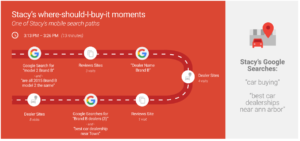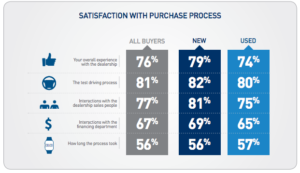Note: This post is intended for automotive retail Dealer Principals, General Managers and Dealer Group Marketing Directors. It is a candid, honest observation, an open question of certain automotive marketing tactics today.
As someone who has worked as a marketer in the auto industry for two decades, a few recent studies, from highly respected organizations may have revealed an uncomfortable truth about a dealer’s (or its advertising agency’s) ability to influence quality auto-shopper traffic to visit its website. These studies, our own research, and the actions of many dealers throughout the country begs the question: has the time come for dealers to go dark and still grow profitably?
Times aren’t changing – they have already changed.
For those unfamiliar with my experience, I’ve helped dealers, dealer groups and dealer associations across the country market and grow their sales and service business for more than 20 years. Throughout that time, I’ve used every marketing strategy and tactic that has been available as the industry has evolved. I have experience driving showroom, phone and internet sales for every brand, in every market, through all economic conditions – from the great late 90s to the disastrous market collapse 2008-09 to the consumer-driven market of today.
When I say “helped,” I mean I sold marketing and advertising solutions to nearly 5,000 privately owned dealerships in the course of my career. This ranged from traditional media, digital marketing and social media to sales force automation, CRM and mobile marketing. Additionally, I’ve called on, presented to or sold marketing solutions to every one of the top 100 dealer groups in the country. I’ve sold in every state, area, or major city. I’ve closed deals with every brand. I’ve had experience with and sold all sorts of mediums and products. I’ve also served at C level functions of a few major industry marketing and technology vendors – some of which you’re most likely contracted with now.
It appears that today’s reality for dealers and General Managers is that many use outdated marketing strategies that have no impact whatsoever on shoppers visiting your website. Sometimes painfully so, particularly when they, their peers and their vendors argue over those outdated strategies. It’s a lot like watching Barnes & Noble and Borders argue over who has the better retail displays while Amazon is plotting to bankrupt them in the background.
There is not a definitive “strategy” to drive more quality traffic to your site today. There is also no digital marketing platform to help you get more shoppers on your site than your closest competitor.
What you’ll see from these recent studies, is today’s automotive shoppers are going to get to your website regardless of your advertising spend. Because of how they shop today, when someone decides to get in the market, they’re going to find you, they’re going to shop you (and your competitors) whether you like it or not. And it doesn’t look like any amount of marketing budget can do anything about it. There is not a definitive “strategy” to drive more quality traffic to your site today. There is also no digital marketing platform to help you get more shoppers on your site than your closest competitor.
As a marketing vendor, I can see the proof that there is no marketing strategy that works like it used to in the not-too-distant past. In part, it’s because of the marketing that the OEM does. However, in a greater part, it’s because of that great equalizer called the internet. Times aren’t changing – they have already changed.
If you need further, authoritative proof, look no further than Polk or Autotrader. The 2015 Automotive Buyer Influence Study is filled with gems for every dealer. One of the things the study pointed out is that the number one factor that drives a shopper to a dealers’ showroom is the internet. It’s actually not even close, as its 400 percent more than every other advertising medium combined. It’s also two times more influential than “prior experience with dealership.” This is something to remember the next time someone tells you how important an “integrated, cross-medium-frequency strategy” is.
As for Polk, it’s interesting to note that the Direct Mail vendors that dealers use purchase data from Polk frequently for conquest data to mail to. Yet Polk, in their own study, points out that Direct Mail accounts for only two percent of your showroom traffic. Again, just two percent. Do the math on that and see how you feel about your sales-expectancy Direct Mail tactics.
Yes, Direct Mail can work for your Service business because of the lower prices of services and products in combination with “coupons.” There is a small place in the market for Service-related Direct Mail, but not for a sales-expectancy outcome. Yes, it also works wonders for short-term Service urgency or OEM recall-related events, but not for sales expectancy events. You might believe that the ROI on your $10,000 mailer was strong and people “brought in the mailers.” But it’s more likely that they were the buyers who were going to buy a car from you anyway. After all, they were already “in market.” One could argue that you could have been better off writing down the prices of your cars with that $10,000 for better third-party site position results with AutoTrader or Cars.com, because the shoppers you send mail to were going to go there too. As a matter of fact much of the data proves that the first media an in-market buyer is exposed to is the internet. Translation: you spent money to mail someone an offer who was already considering your brand and your dealership before your offer got to their mailbox.
If studies from Polk & Autotrader don’t impress you or you think they’re just trying to get you to increase your spend with them, there’s more proof from another company – one that has more empirical proof than all the other companies combined. They have quantitative and qualitative data that all of that automotive shopper traffic on your website was going to get there regardless of your Search Engine Marketing (SEM) strategies. Of course, the company I’m talking about is one you might have heard of – Google.
A recent auto-buyer study from Google should have you question all of your sales-expectancy ROI reports. In their recent 2016 Auto Buyer Study , The Car Buying Process they illustrate that today’s shoppers have more than 90 dealership engagements during their shopping process. Every single one of the shoppers uses Google to search for dealerships in their respective cities for the manufacturer of their choice. Google’s study goes as far as to detail the shoppers’ journey from stimulus to purchase. Literally every search term, click, page, visit and response. The study represents a typical journey for all car buyers that includes research at the OEM level, consumer reports level, third-party research and inventory aggregation sites, dealership websites, online reviews and even the crowd-sourcing social media level. It’s what every single shopper does today.
You may have already seen it yourself in your own showroom: customers shopping, checking out reviews, checking out prices and vehicle mileage on their phones and tablets. I’ve seen customers on their laptops in showrooms, shoulder-to-shoulder with bewildered Sales Managers on their heels trying to build value and defend their vehicles’ prices. If you’re a salesperson in the car business today who hasn’t had a customer show you a printed VDP from your competitor or waive their smartphone in your face comparing your competitor’s prices to yours, then you haven’t been in the business for more than 30 days. It’s just one of the reality’s in today’s car business.
Remember, buying a car is a big purchase for your shoppers. It’s the second largest purchase they make and one they make every few years. So, if you are one of a few dealers in a 50-mile radius, and the only one that can sell the brand they want, people will find you and see your inventory – along with your competitors’ inventory, too. Even for pre-owned vehicles.
Here’s something to consider. If you’re like the majority of dealerships, for pre-owned vehicles you use an inventory pricing tool (vAuto, AAX, FirstLook, etc). One of the foremost reasons you use that tool is to ensure your pre-owned unit is comparably and competitively priced relative to the competition and demand in your market for that vehicle. Why? Because you know shoppers visit you and your competitor sites equally. You clearly know people are using the internet/Google when shopping for pre-owned units. Otherwise, you wouldn’t bother with pricing your vehicle relative to the market would you?
However, for some reason, dealers behave and spend differently for new vehicles. It’s painful to watch dealers and vendors dump more money into marketing strategies with the failed assumption that correlation is equal to causation. Correlating a click to the causation of a sale today is like correlating the fact that a customer owns an iPad and that therefore led to the subsequent purchase of a car from a particular dealership. Yes, perhaps the customer perused your website on an iPad’s browser, and you can correlate the two (your website and the ipad). However, the iPad had no relevance to your inventory nor what caused the initial visit nor subsequent purchase from you. Similarly, your pay-per-click (PPC) ad unit has no direct correlation to a purchase from you, as the consumer was going to visit your website for the purpose of purchasing his or her next car anyway.
Correlation does not equal causation; yet too many people are still trying to prove that it does with results that simply aren’t there. These recent studies from Google, Polk, et. al., may show that to be true.
“Today’s automotive shoppers and buyers are going to get to your website regardless of your advertising spend.”
If you want to have some fun, have someone argue against Google, Polk or any other online shopper report. Get some popcorn because it will be entertaining. If you need more proof, here is a 15-minute exercise you can do:
- Grab a list of five random buyers from last months sales report, call them and ask if they saw your website before they bought.
- Then, ask them if they saw your competitors’ websites also.
I’m willing to bet all five say yes.
If AutoTrader, Polk, and Google aren’t relevant or important enough players in your world to convince you, you need to listen to consumers. With the amount that’s spent in marketing dollars to help them find your website, it’s rare we’re hearing how difficult and frustrating it is to find dealers or the cars they’re hoping to buy.
In another recent AutoTrader survey, what frustrates customers during the process isn’t finding your website or your dealership, it’s the buying experience – the process they go through after having engaged with you. They’re all begging for a superior experience when they engage with you. An experience that they’d be very happy to rave about to their friends and family, either directly or via social media. (You can take that as a free hint.) Here are some takeaways from that study that can help your dealership differentiate against competitors with a superior consumer experience:
- Nearly three-fourths (72 percent) of consumers say they would visit dealerships more often if the buying process were improved.
- Two-thirds (66 percent) of consumers say that they would be much more likely to buy from a dealership that offers their preferred experience.
- Over half (53 percent) of consumers would buy a vehicle more often if the buying process were improved.
- ZERO expressed a dissatisfaction in the internet’s ability to show them all of the dealerships and vehicles in their market.
OK, I added that last one, but you get the point.
How then can you gain a competitive advantage in your market? How can you increase sales, profitability, marketshare and employee retention? I’ll share with you what all of the shopper study data says: give your customers superior experiences by INVESTING IN YOUR PEOPLE AND YOUR PROCESSES. Invest in a process that shows your shoppers that you value the fact that they’re in your store, not that you know they’re shopping for your store because only one of those are a given. Invest in sales training programs from Grant Cardone, Stuker, The “Big Dog” Jim Zieglar and others. Invest in BDC process and follow-up from organizations like Traver, Phone Ninjas and more. Get reviews help and training from companies like Social Dealer, DealerRater and Yelp. In making investments with companies like these, you’ll see a direct and immediate lift in sales, profitability, employee satisfaction and customer satisfaction. That all translates to strong differentiation in your market and sustainable month-over-month – and year-over-year – sales volume growth.
Give your customers superior experiences by INVESTING IN YOUR PEOPLE AND YOUR PROCESSES.
So, you’re asking, if the studies show that advertising budget has little to no influence on your sales volumes, what does? There are several factors that have significant influence on your sales volumes, few of which you have nearly no control over, others you do: location, price, product, trust, and time.
Location: It’s true; there are some dealerships that happen to be in amazing, high-density locations and because of that, even fair stewardship and operations will have that dealership perform among the top in their district. Location, location, location. It is what it is.
Price: Sorry, but your manufacturer dictates much of that. With respect to pre-owned, market dynamics (velocity, supply and demand) influence those prices and margins. And as most of you know, “price” is among the smallest factors that influence a person to engage with your dealership. The aforementioned AutoTrader Study found that 54 percent of people would buy from a dealership with a better experience than a lower price.
Product: Again, your manufacturer has control over design, performance and reliability. For example, both Hyundai and Kia started with poor product perceptions with consumers and worked to change those perceptions through consumer awards and third-party review rewards. Your dealership has no control over the product that you represent.
Trust: Here is where you have the most influence. This is a matter of accountability on your part, training, and – most of all – individual trustworthiness and accountability. Money spent on teaching and leveraging accountability is directly proportional to profitability and subsequent monthly sales volumes because of the immense impact that review sites and social media have on your shoppers’ perceptions of your dealership. In other words, shoppers believe they’ll be treated the way their friends and neighbors were treated by your team.
Time: Invest here. The training vendors mentioned above will help in this regard. An empowered and experienced staff performs faster, asks fewer questions of their management and makes fewer mistakes. All of this contributes greatly toward saving time in the sales process. If your sales team tells you your CRM tool slows them down then, invest in more support, training, and configuration from your CRM vendor to resolve the issue. In today’s time and attention-crunched market, the fastest way to build trust with a buyer is to prove that you value and respect their time. When they’re at your dealership, they’re trusting you with their most cherished resource – time. Invest in training your entire staff to treat them like you know that.
One again, times aren’t changing, they’ve already changed. Today’s automotive shoppers instinctively use the internet and Google to begin and end their vehicle and dealership selection process. As a dealership, there is little you can do to influence quality auto-shopper traffic to your website. People who are in the market to buy a car – in your market – are going to find your website and your inventory. Your PPC doesn’t make more quality buyers. It’s just another link that the already-interested buyer can click. If you think about it, no online shopper searches for a dealer and then walks away from their laptop in total frustration because they didn’t see ads in the search results. Searching the internet and Google in particular have made it beyond easy for them to find you. In fact, it’s nearly impossible that you wouldn’t be found by any shopper on any device in any market.
On a final note, here are a few takeaways:
- Branding is important because the last problem you want to have is obscurity. Intelligent and efficient branding solves obscurity in automotive retail, not direct response/sales expectancy advertising.
- Keep advertising digitally for service business. The average RO is $275, and there are many places a customer can get a tune-up. However, there are only three to five places within driving distance to buy their next $30,000-dollar vehicle.
- Move your sales expectancy dollars to investments in your customers’ experiences. Invest in good, honest and transparent processes in your dealership. Invest in sales training and train every day that you sell cars. Invest in time-saving tools and consultants who can help you reduce the time it takes for the people who visit your dealership to find, buy and leave with that they want.
Lastly, remember the internet is there for your customers to find you. It’s not just the aforementioned studies that are seeing this; many dealers and organizations are coming to the same conclusion. Therefore, you should focus on being profitable and having a strong competitive differentiator in your market to give the best customer experience once the customer has found you.
This piece is meant as a discussion. Dealers reading this as well as I would love to hear your thoughts on the studies, the changing landscape in automotive marketing that you see, or about the alternative tactics mentioned above. Thank you for taking the time for reading. If you have any additional questions on what you read today, you can reach me at ronmorrison@pureinfluencer.net.



